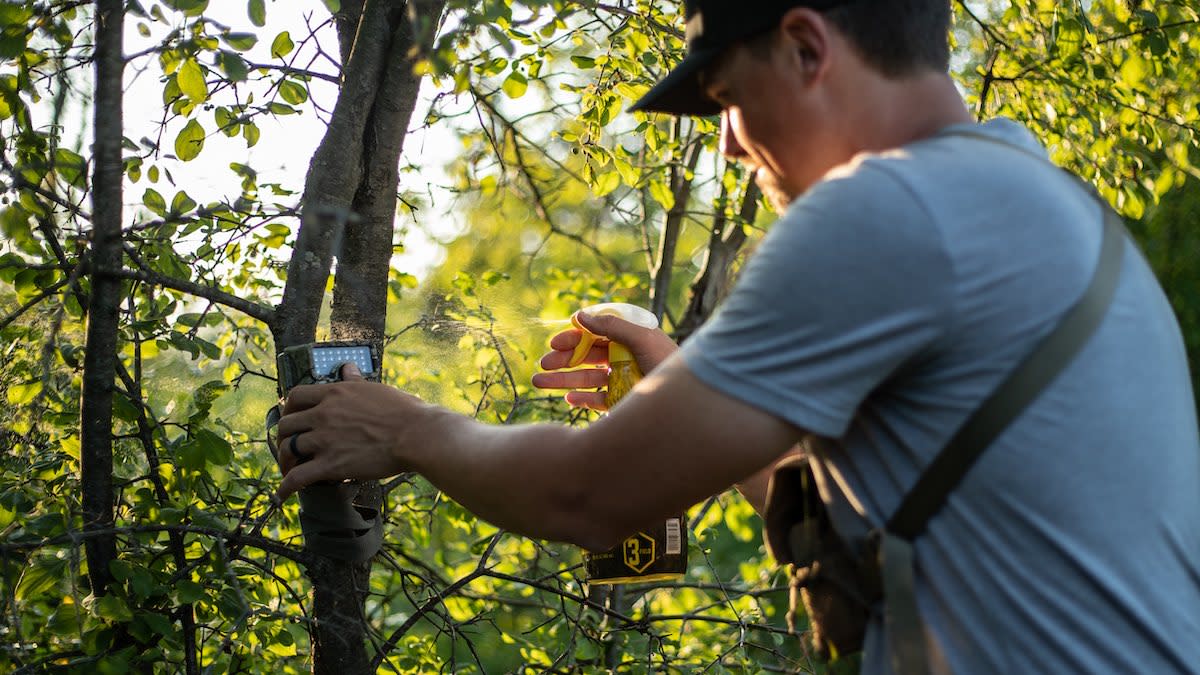
Hang a trail camera in front of a pile of corn or a mineral block and you’re almost guaranteed to get an SD card full of deer photos. It used to be that simple. But with increasing concerns over disease in recent years, more and more states are outlawing the use of bait at trail camera sites. For many deer hunters hoping to get quality intel during the summer or fall, this can pose a significant challenge.
Fortunately, there’s a simple alternative that is affordable, effective, and quickly becoming the go-to trail cam tactic for whitetail experts across the country.
The Answer
This alternative, which in my view is the single best way to get bucks on trail camera without bait, is the use of scrapes to attract deer into photo range.
Scrapes are a form of deer sign comprised of two components: an overhanging branch at deer nose level, known as a licking branch, and a scuffed area on the ground beneath it. Deer create and use these as signposts for communication, leaving a chemical signature by rubbing their foreheads on the branches and urinating on the ground below. While scrapes are most utilized and visible during the fall, whitetail consultant Steve Bartylla believes that deer will go out of their way to check scrapes even outside of those months.
“I look at it as a communication hub,” Bartylla said. “They’re not pawing the ground hardly at all then, but they’re working that licking branch.”
Making this tool even more useful is the fact that human-made imitations of scrapes, known as mock scrapes, are just as effective at encouraging deer visitation. The ability to place a mock scrape in a location of your choice, according to Bartylla, is what makes them the ideal tool for collecting high-quality trail camera images.
“When you get them in the right spot you’re going to end up having just about every buck in that area stopping by to check it out at least once or twice a month,” he said.
Natural Scrapes
The first option to consider for your camera location is a pre-existing scrape that is already in use. Ideally, you’ll want to place your trail camera on a scrape that’s well used, as evidenced by a large, bowled out scrape on the ground and made even better if that scrape shows up in the same place year after year.
This is a great option if you can find one of these high-quality scrapes already located in an area of high deer use that’s also easy to reach without spooking deer. That said, take care when positioning your trail cam to make as little disturbance as possible. Consider placing your camera above a deer’s eye level and angled down to avoid spooking nervous bucks.
Mock Scrapes
The second option is to create a scrape in an area of your choosing that you can access without educating deer. A mock scrape can be made in a number of ways, but all must include some kind of overhanging branch (or a similar substitute) and a scuffed-up oval of dirt underneath. In the interest of capturing high numbers of buck photos, placing a mock scrape in a visually conspicuous location is often beneficial, like the edge of a field or right in the middle of an opening.
“Just make that licking branch literally stick out like a turd in a punchbowl,” Bartylla said. “Put it right smack dab in front of that buck’s nose.”
The easiest way to do this is by bending or tying a branch down to deer level from a tree that is already on the edge of a field, clearing, or food plot. Then, kick up the ground underneath. This works well enough, but many hunters have found that you can make mock scrape trail cam locations even more attractive by using unique materials for a licking branch.
Heath Cisco, an accomplished Ohio bowhunter, has found that pine branches work particularly well for this application.
“I don’t know what it is, maybe it’s the sap that the holds the scent more,” Cisco said. “But it seems like if you hang these branches over a scrape the deer are funneled to it.”
Jeff Sturgis, founder of Whitetail Habitat Solutions, has found similar success by hanging a grapevine as a licking branch. Don Higgins of Real World Whitetails has been known to do something similar with a piece of thick rope.
The last mock scrape trick to be considered for cameras is the placement of an entire “scrape tree” out in the middle of an opening. The idea here is to sink a portion of a tree or a post affixed with branches to simulate a tree. The scrape itself will attract deer, but the presence of the lone “tree” in the opening will attract attention as well. Deer are attracted to trees in an opening the same way bass are to structure in a lake.
Finally, you might want to consider adding some kind of scent to your mock scrape to encourage deer use. There are plenty of scrape-specific options on the market, but I’ve personally found, and research confirms, that human urine can be just as effective at kick-starting a scrape location.
Whether or not baiting or scents are allowed in your state, I’d encourage you to consider using a scrape for your next trail camera site. You’ll save money and time while still capturing plenty of great bucks on trail camera. What more could you ask for?

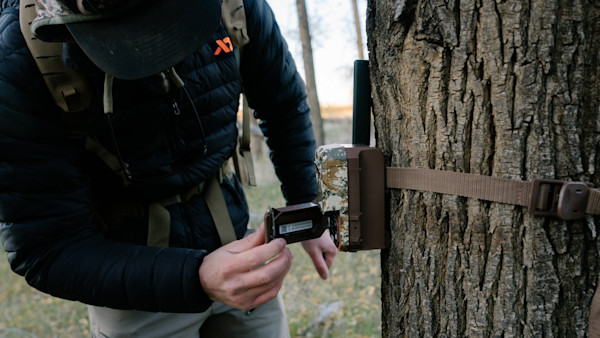
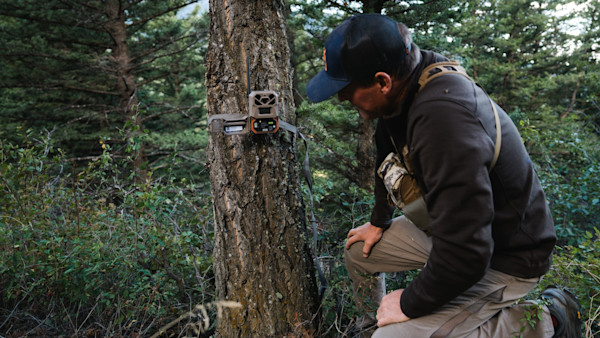
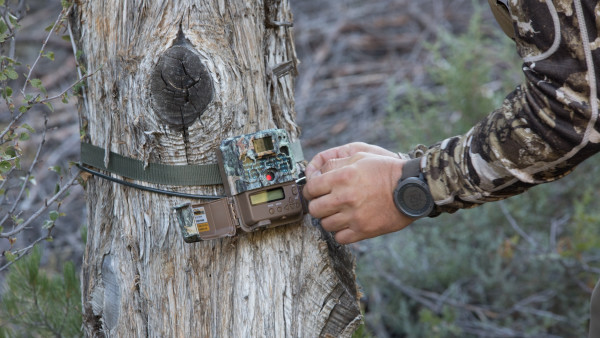
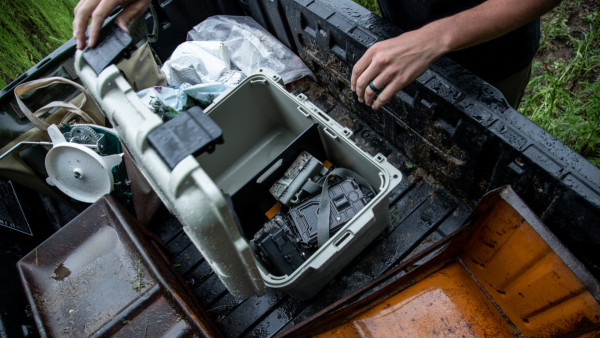
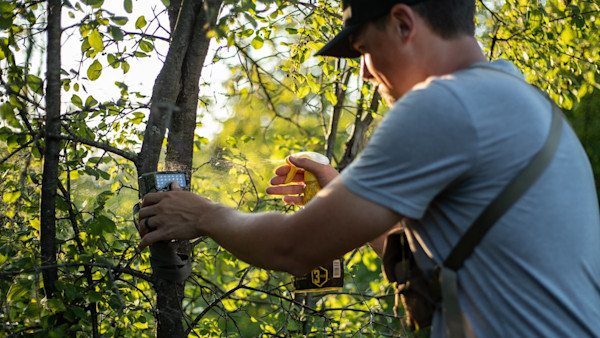


Conversation